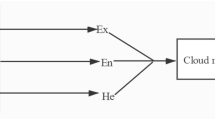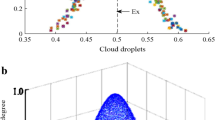Abstract
To objectively analyze the effect of the water resources carrying capacity (WRCC) on sustainable regional development, a case study of Heilongjiang Province, China, is conducted. With a focus on the coordinated development of the water resources system, 16 indices are selected to establish an index-based WRCC evaluation system. In addition, based on the index values, initial values are obtained using a fuzzy combined weighting method. The WRCC evaluation levels are objectively generated using cloud model, and the temporal and spatial evolution of the WRCC in the study area is analyzed. The obstacle degree is used to analyze quantitatively the restraint relationship of each index to the carrying capacity. The present study classifies the WRCC into five evaluation levels: level I ([0.01, 0.21]), level II ([0.21, 0.37]), level III ([0.37, 0.47]), level IV ([0.47, 0.63]), and level V ([0.63, 0.82]). When determining the WRCC of each of the 13 observation points, the trend is consistent with both social and economic development, indicating that the evaluation criteria have a high degree of credibility. The main influencing factors of the WRCC also change, between 1999 and 2007, the irrigation coverage, amount of water resources per unit area, and gross domestic product per capita were the main factors, between 2008 and 2014, the agricultural water pollution index, population density, and percentage of industrial wastewater discharge compliant with consent conditions were the main factors. In addition, between 1999 and 2014, the ecological environment gradually became the main subsystem that limits the WRCC.





Similar content being viewed by others
References
Cheng K, Fu Q, Chen X, Li TX, Jiang QX, Ma XS, Zhao K (2015) Adaptive Allocation Modeling for a Complex System of Regional Water and Land Resources Based on Information Entropy and its Application. Water Resour Manag 29(14):4977–4993
Cheng J, Zhou K, Chen D, Fan J (2016) Evaluation and analysis of provincial differences in resources and environment carrying capacity in China. Chin Geogr Sci 26(4):539–549
Fu Q, Meng FX, Li TX, Liu D, Gong FL, Osman A, Li Y (2016) Cloud model-based analysis of regional sustainable water resource utilization schemes. Int JAgric Biol Eng 9(5):67–75
Fu Q, Gong FL, Jiang QX, Cheng K, Dong H, Ma XS (2014) Risk assessment of the city water resources system based on Pansystems Observation-Control Model of Periphery. Nat Hazards 71(3):1899–1912
Giri S, Qiu Z, Prato T, Luo B (2016) An Integrated Approach for Targeting Critical Source Areas to Control Nonpoint Source Pollution in Watersheds. Water Resour Manag 30(14):5087–5100
Harris J (1999) Carrying capacity in agriculture: Globe and regional issue. Ecol Econ 129(3):443–461
Kato T, Endo A (2017) Contrasting two dimensions of disaster-induced water-shortage experiences: water availability and access. Water. https://doi.org/10.3390/w9120982
Li M, Guo P, Singh VP, Yang G (2016) An uncertainty-based framework for agricultural water-land resources allocation and risk evaluation. Agric Water Manag 177:10–23
Li DY, Cheung D, Shi X, Ng V (1998) Uncertainty reasoning based on cloud models in controllers. Comput Math Appl 35(3):99–123
Li DY, Liu C, Gan W (2009) A new cognitive model: Cloud model. Int J Intell Syst 24(3):357–375
Liu J, Dong S, Mao Q (2012) Comprehensive evaluation of the water resource carrying capacity for China. Geogr Nat Resour 33(1):92–99
Liu H, Liu H (2012) A Study on the Change Trends of Regional Water Resource Carrying Capacity. Green Commun Netw 113(4):1375–1380
Liu Z, Shao J, Xu W, Meng Y (2013) Prediction of rock burst classification using the technique of cloud models with attribution weight. Nat Hazards 68(2):549–568
Meng L, Chen Y, Li W, Zhao R (2009) Fuzzy comprehensive evaluation model for water resources carrying capacity in Tarim River Basin, **njiang, China. Chin Geogr Sci 19(1):89–95
Parhoudeh S, Baziar A, Mazareie A, Kavousi-Fard A (2016) A novel stochastic framework based on fuzzy cloud theory for modeling uncertainty in the micro-grids. Int J Electr Power Energy Syst 80(9):73–80
Peterson D (2002) Florida keys carrying capacity study. Proceedings of the Water Environment Federation (13):489-501
Rijsberman M, Ven F (2000) Different approaches to assessment of design and management of sustainable urban water systems. Environ Impact Assess Rev 20(3):333
Sawunyama T, Senzanje A, Mhizha A (2006) Estimation of small reservoir storage capacities in Limpopo River Basin using geographical information systems (GIS) and remotely sensed surface areas: Case of Mzingwane catchment. Phys Chem Earth, Parts A/B/C 31(15):935–943
Sleeser M (1990) Enhancement of Carrying Capacity Options. The Resource Use Institute, London
Wang J, Zhai Z, Sang X, Li H (2017) Study on index system and judgment criterion of water resources carrying capacity. J Hydraul Eng 48(9):1023–1029 (in Chinese)
Wang WH, Zhang C, Zhang Q (2014) An anomaly detection model based on cloud model and danger theory. Trustworthy Comput Serv 426:115–122
Yang J, Lei K, Khu S, Meng W (2015) Assessment of water resources carrying capacity for sustainable development based on a system dynamics model: a case study of Tieling City, China. Water Resour Manag 29(3):885–899
Zhang J, Yu S (2007) Risk analysis on groundwater resources carrying capacity based on blind number theory. Wuhan Univ J Nat Sci 12(4):669–676
Zhou K, Lin Y, Deng H, Li J, Liu C (2016) Prediction of rock burst classification using cloud model with entropy weight. Trans Nonferrous Metals Soc China 26(7):1995–2002
Zhou R, Pan Z, ** J, Li C, Ning S (2017) Forewarning Model of Regional Water Resources Carrying Capacity Based on Combination Weights and Entropy Principles. Entropy. https://doi.org/10.3390/e19110574
Zuo Q, Zhang X (2015) Dynamic carrying capacity of water resources under climate change. J Hydraul Eng 46(4):387–395 (in Chinese)
Acknowledgements
Many thanks to the National Natural Science Foundation of China (No: 51609039), the Natural Science Foundation of Heilongjiang Province (No. E2017006), the China Postdoctoral Science Foundation (funded project No. 2016 M601410), the Heilongjiang Province Postdoctoral Science Foundation (funded project No. LBH-Z16025), and the Key Laboratory of Efficient Use of Agricultural Water Resources, Ministry of Agriculture, P.R. China (No. 2017008).
Author information
Authors and Affiliations
Corresponding author
Additional information
Highlights
1. The criteria of regional WRCC are determined to scientifically evaluate the WRCC.
2. A fuzzy combined weighting method is proposed to effectively solve the fuzzy relation and uncertainty between the evaluation indices of the WRCC.
3. The quantitative relation of each index to the WRCC is quantified by introducing the obstacle degree.
Rights and permissions
About this article
Cite this article
Cheng, K., Fu, Q., Meng, J. et al. Analysis of the Spatial Variation and Identification of Factors Affecting the Water Resources Carrying Capacity Based on the Cloud Model. Water Resour Manage 32, 2767–2781 (2018). https://doi.org/10.1007/s11269-018-1957-x
Received:
Accepted:
Published:
Issue Date:
DOI: https://doi.org/10.1007/s11269-018-1957-x




